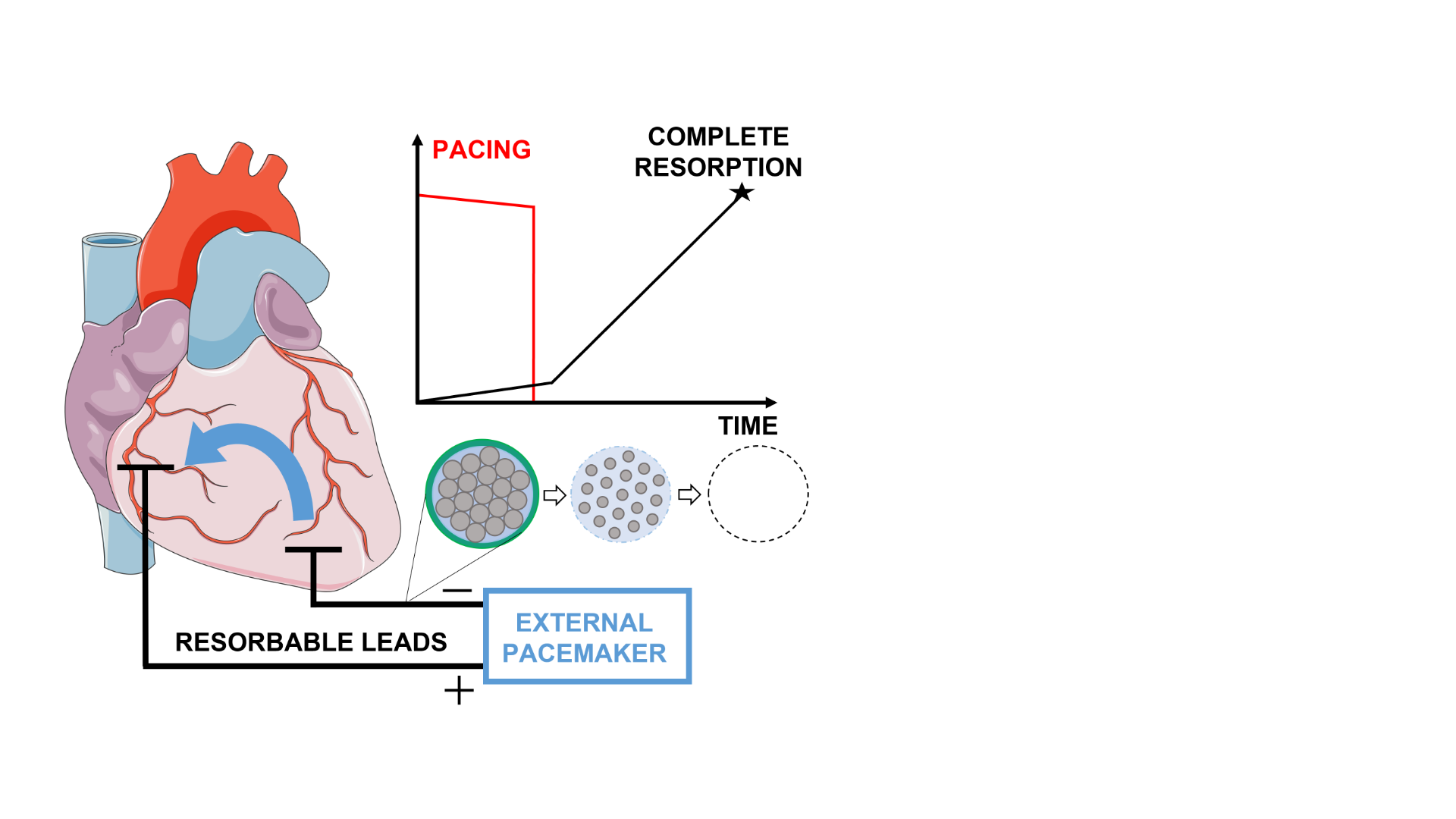
Resorbable Molybdenum Temporary Cardiac Electrodes |
Medical Need
Postoperative cardiac arrhythmias are common after cardiac surgery. They are routinely treated with external pacemakers and temporary epicardial leads prophylactically implanted at the time of surgery. Standard stainless steel leads can cause complications during manual extraction several days after surgery. However, cutting the leads and leaving the remains in the body, which is necessary in a relevant number of cases, leads to risks of infection and migration, that may entail revision surgery. Furthermore, the treating clinician and the manufacturer face legal uncertainty since the leads are not intended as long-time implants.
The project introduces the completely novel approach of using bioresorbable temporary leads made of molybdenum and polymers. These leads may be left in the body intentionally and then vanish by resorption after a defined time, thus avoiding the problems and risks associated with non-resorbable leads made of steel.
Temporary epicardial leads, bioresorbable, molybdenum
Redlich, C.; Schauer, A.; Scheibler, J.; Poehle, G.; Barthel, P.; Maennel, A.; Adams, V.; Weissgaerber, T.; Linke, A.; Quadbeck, P.; et al. In-Vitro Degradation Behavior and Biocompatibility of Bioresorbable Molybdenum. 1(5), 761
Schauer, A.; Redlich, C.; Scheibler, J.; Poehle, G.; Barthel, P.; Maennel, A.; Adams, V.; Weissgaerber, T.; Linke, A.; Quadbeck, P. Biocompatibility and Degradation Behavior of Molybdenum in an In Vivo Rat Model. Materials 2021, 14, 7776.
Project team members |
Clinician |
TU Dresden, Faculty of Medicine, University Hospital Dresden, Department of Internal Medicine and Cardiology, Dresden Heart Centre
TU Dresden, Faculty of Medicine, University Hospital Dresden, Department of Cardiac Surgery, Dresden Heart Centre
TU Dresden, Institute of Pharmacology and Toxicology, Institute of Clinical Pharmacology
Abstract
Postoperative cardiac bradyarrhythmias are common after cardiac surgery. Bradyarrhythmias are routinely treated with an external pacemaker using temporary epicardial leads. However, state-of-the-art stainless steel epicardial leads can cause complications during manual extraction several days after surgery. Cutting the leads and leaving the remains in the body, however, also leads to risks of infection and migration, that may entail revision surgery. Also, the treating clinician and the distributor face legal uncertainty since the leads are not intended as long-time implants.
Thus, the project “ReMoTe CarE” introduces the completely novel approach of using biodegradable temporary leads that intentionally remain in the body and then vanish by resorption after a defined time. The basis of this approach is the use of molybdenum (Mo), whose favorable properties were recently demonstrated by the project partners. Mo has uniform degradation in the physiological environment, high mechanical strength and electrical conductivity and is biocompatible. Electrical insulation against the surrounding tissues is achieved by coating with absorbable biopolymer layers.
The key experiment is a proof-of-principle sensing and pacing in an in-vivo rat model at the Medical Faculty of TU Dresden. Ex-vivo demonstrator testing, in-vitro toxicology and cell compatibility investigations will also be conducted. The Fraunhofer IFAM Dresden will test and optimize the mechanical, electrical and degradation characteristics of the material and manufacture the demonstrator. A successful realization of the idea will help avoid the complications and risks associated with non-resorbable epicardial leads, thus benefiting patients, health care professionals and care system alike.
News and Results
Dr. Georg Pöhle from Fraunhofer IFAM talks about the ReMoTe CarE project at COMPAMED 2022. In it, resorbable molybdenum is used to manufacture self-dissolving pacemaker wires. The material is high-strength, biologically compatible and degrades slowly and evenly in the body.

